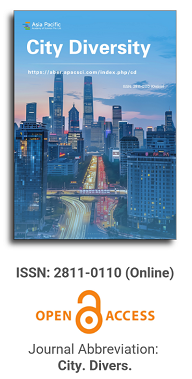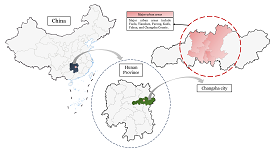
Asia Pacific Academy of Science Pte. Ltd. (APACSCI) specializes in international journal publishing. APACSCI adopts the open access publishing model and provides an important communication bridge for academic groups whose interest fields include engineering, technology, medicine, computer, mathematics, agriculture and forestry, and environment.

As China's pillar industry, the property market has suffered a considerable impact in recent years, with a decline in turnover and many developers at risk of bankruptcy. As one of the most concerned factors for stakeholders, housing prices need to be predicted more objectively and accurately to minimize decision-making errors by developers and consumers. Many prediction models in recent years have been unfriendly to consumers due to technical difficulties, high data demand, and varying factors affecting house prices in different regions. A uniform model across the country cannot capture local differences accurately, so this study compares and analyses the fitting effects of multiple machine learning models using February 2024 new building data in Changsha as an example, aiming to provide consumers with a simple and practical reference for prediction methods. The modeling exploration applies several regression techniques based on machine learning algorithms, such as Stepwise regression, Robust regression, Lasso regression, Ridge regression, Ordinary Least Squares (OLS) regression, Extreme Gradient Boosted regression (XGBoost), and Random Forest (RF) regression. These algorithms are used to construct forecasting models, and the best-performing model is selected by conducting a comparative analysis of the forecasting errors obtained between these models. The research found that machine learning is a practical approach to property price prediction, with least squares regression and Lasso regression providing relatively more convincing results.
Inclusive urban art: Rethinking public space for functional diversity and active participation
Vol 6, Issue 1, 2025
Download PDF
Abstract
The growing importance of urban spaces that facilitate socio-cultural exchange and artistic expression generates a series of current debates on inclusion within urban arts since there is not more emphasis on considering accessibility and the active participation of people and artists with disabilities as fundamental aspects. The main goal is to contribute to the comprehensive development of the theory of analytical thinking through the artistic representation of public space to validate accessibility and functional diversity, which affect inclusive design and promote active participation in urban art. The development of arguments is classified into ⅰ) the evolution of urban art and its relationship with functional diversity; ⅱ) participation of (artists and) people with disabilities in urban art; and ⅲ) urban art as an inclusive and transformative platform. This section discusses the argumentative structure in creative production that urban art is a space for social interaction and the construction of collective identity through art representation and inclusion. It is to deepen this theory of analytical thinking to contribute to the development of artworks in inclusive and accessible public spaces, depending on urban infrastructures. Urban art must have a space where all identities and collectives that are concerned about the restriction towards a more diverse and equitable urban culture for the whole society, independent of people with disabilities in public space, are recognized by the artistic work, challenging ideas about the meaning of being an artist with functional diversity.
Keywords
References
- Gabriel OW, Hoffmann-Martinot V, Savitch HV. Urban democracy. Springer Science & Business Media; 2012.
- King LA. Democracy and City Life. Politics, Philosophy & Economics. 2004; 3(1): 97–124. doi: 10.1177/1470594x04039984
- Elliott S. The Art of Accessibility: A Critical Analysis of Ableism at Washington University in St. Louis. The Stanford Journal of Science, Technology, and Society. 2023; 17(1):1–17.
- Ashley AJ, Loh CG, Bubb K, Durham L. Diversity, equity, and inclusion practices in arts and cultural planning. Journal of Urban Affairs. 2021; 44(4–5): 727–747. doi: 10.1080/07352166.2020.1834405
- Hinojosa KH, Quiroz SF. Urban planning for equity (Spanish). In: Ramírez Ibarra R (editor). Ciudadanía y multiculturalismo: Convergencias y retos del hábitat metropolitano. Comunicación Científica; 2023. pp. 97–120.
- Vargas Pineda DR, Jiménez MC, Samacá Pulido EJ. Art as an occupation, a path towards inclusion (Spanish). Available online: https://repositorio.ecr.edu.co/items/72f2267d-ce17-4561-b1c7-f7eb0334158f (accessed on 28 November 2024).
- Hall E. Spaces of social inclusion and belonging for people with intellectual disabilities. Journal of Intellectual Disability Research. 2010; 54(s1): 48–57. doi: 10.1111/j.1365-2788.2009.01237.x
- Ellcessor E. Restricted Access: Media, Disability, and the Politics of Participation. NYU Press; 2016.
- Le Roux M. There’s a place for people with disabilities within the arts: Exploring how interaction with the performing arts may facilitate the social and economic inclusion of youth with disabilities [Master’s thesis]. University of Cape Town; 2018.
- Chheda K, Baxi P, Agarwal T, et al. Perspectives on barriers to Social Inclusion (SI) for disabled individuals in the performing arts. Multidisciplinary Reviews. 2024; 6: 2023ss048. doi: 10.31893/multirev.2023ss048
- Laaksonen A, Interarts Agency, Barcelona, Council of Europe Publishing. Making culture accessible: Access, participation and cultural provision in the context of cultural rights in Europe. Available online: https://catalogus.boekman.nl/pub/P14-0379.pdf (accessed on 28 November 2024).
- Titchkosky T. The question of access: Disability, Space, Meaning. University of Toronto Press; 2011.
- le Roux M, Kathard H, Lorenzo T. Creating inclusive Performing Arts practices for development of youth with disabilities: A critical ethnographic study. African Journal of Disability. 2021; 10. doi: 10.4102/ajod.v10i0.753
- Kuppers P. Studying Disability Arts and culture: An Introduction. Bloomsbury Publishing; 2017.
- Walker P. From Community Presence to Sense of Place: Community Experiences of Adults with Developmental Disabilities. Journal of the Association for Persons with Severe Handicaps. 1999; 24(1): 23–32. doi: 10.2511/rpsd.24.1.23
- Hall T, Robertson I. Public Art and Urban Regeneration: Advocacy, claims and critical debates. Landscape Research. 2001; 26(1): 5–26. doi: 10.1080/01426390120024457
- Connor DJ. Urban narratives: Portraits in Progress, Life at the Intersections of Learning Disability, Race, & Social Class. Peter Lang; 2008.
- Sandoval Moya LE. Inhabiting the public: The potential of urban art in the public space of the city of Cuernavaca (Spanish) [Master’s thesis]. Universidad Autónoma del Estado de Morelos; 2023.
- Arevalo Iglesias L. Urban art and local communication: Appropriation of visual discourses for change in Galicia and Northern Portugal (2008–2016) (Spanish) [PhD thesis]. Universidade de Vigo; 2017.
- Abberley P. The Concept of Oppression and the Development of a Social Theory of Disability. Disability, Handicap & Society. 1987; 2(1): 5–19. doi: 10.1080/02674648766780021
- McNulty N. A social theory of disability | International Socialist [Review]. Available online: https://isreview.org/issue/90/social-theory-disability/ (accessed on 28 November 2024).
- Goodley D, Hughes B, Davis L. Disability and Social Theory: New Developments and Directions. Palgrave Macmillan; 2012.
- Stafford L, Vanik L, Bates LK. Disability Justice and Urban Planning. Planning Theory & Practice. 2022; 23(1): 101–142. doi: 10.1080/14649357.2022.2035545
- Sullivan K, Mauldin B. Accessibility and the Arts: Reconsidering the Role of the Artist. Available online: https://www.lacountyarts.org/sites/default/files/accessibilityandthearts-reconsideringtheroleoftheartist.pdf (accessed on 28 November 2024).
- Sulewski JS, Boeltzig H, Hasnain R. Art and Disability: Intersecting Identities Among Young Artists with Disabilities. Disability Studies Quarterly. 2012; 32(1). doi: 10.18061/dsq.v32i1.3034
- Weisen M. International Perspectives on the Cultural Accessibility of People with Disabilities. In: Proceedings of the Come-in Thematic Conference; 26 June 2018; Erfurt, Germany. pp. 12–17.
- Ardeshiri M, Esteghlal A, Etesam I. Explaining the concept of flexibility in urban spaces. International Journal of Applied Arts Studies (IJAPAS). 2016; 1(1): 79–91.
- Mínguez Martínez E, Vera Moure M, Meseguer García D. New Urban Context, Flexible Public Spaces: 10 basic principles (Spanish). Available online: https://eminguez.com/wp-content/uploads/2013/06/Nuevo_Contexto_Urbano_Espacios_Publicos_Flexibles_10_Principios_Basicos.pdf (accessed on 28 November 2024).
- Ahmed Elewa AK. Flexible Public Spaces through Spatial Urban Interventions, Towards Resilient Cities. European Journal of Sustainable Development. 2019; 8(4): 152. doi: 10.14207/ejsd.2019.v8n4p152
- Hickey-Moody A. Arts and Disability. Oxford Research Encyclopedia of Education. 2021. doi: 10.1093/acrefore/9780190264093.013.37
- Saud NB. Enabling [Dis]abled Artists across Culture and Arts Fosters Positive Peace in Nepal. Available online: https://www.britishcouncil.org/sites/default/files/cultural-relations-collection-2023-enabling_disabled_artists_across_culture_0.pdf (accessed on 28 November 2024).
- Youkhana E. Creative Activism and Art Against Urban Renaissance and Social Exclusion—Space Sensitive Approaches to the Study of Collective Action and Belonging. Sociology Compass. 2014; 8(2): 172–186. doi: 10.1111/soc4.12122
- Velázquez Ruiz D, Solano Meneses EE. Semiotics of the City: A Look from Universal Accessibility (Spanish). In: Ramos MTO, Susunaga CF, Fragoso-Susunaga O, Córdoba Flores C (editors). Semiotic interactions between design, art and culture (Spanish). Universidad Autónoma Metropolitana; 2023. pp. 243–260.
- Milner P, Kelly B. Community participation and inclusion: People with disabilities defining their place. Disability & Society. 2009; 24(1): 47–62. doi: 10.1080/09687590802535410
- Bal A, Waitoller FR, Mawene D, Gorham A. Culture, context, and disability: A systematic literature review of cultural-historical activity theory-based studies on the teaching and learning of students with disabilities. Review of Education, Pedagogy, and Cultural Studies. 2020; 43(4): 293–337. doi: 10.1080/10714413.2020.1829312
- Hassanein EEA. Inclusion, Disability and Culture. Sense Publishers; 2015. doi: 10.1007/978-94-6209-923-4
- Scheer J, Groce N. Impairment as a Human Constant: Cross-Cultural and Historical Perspectives on Variation. Journal of Social Issues. 1988; 44(1): 23–37. doi: 10.1111/j.1540-4560.1988.tb02046.x
- Mercer C. Cultural planning for urban development and creative cities. Available online: http://www.kulturplan-oresund.dk/pdf/Shanghai_cultural_planning_paper.pdf (accessed on 28 November 2024).
- Naylor TD, Florida R. The Rise of the Creative Class: And How It’s Transforming Work, Leisure, Community and Everyday Life. Canadian Public Policy/Analyse de Politiques. 2003; 29(3): 378. doi: 10.2307/3552294
- Florida R. The Rise of the Creative Class...and how it’s transforming work, leisure, community and everyday life. Basic Books; 2002.
- Villalba M. Urban art as a form of expression (Spanish). Available online: https://sites.ualberta.ca/~vruetalo/Sarli-Bo%20Research/Film%20Texts/371_libro.pdf#page=77 (accessed on 28 November 2025).
- Leahy A, Ferri D. Cultural Policies That Facilitate the Participation of Persons with Disabilities in the Arts: Findings from a Qualitative Multi-National Study. Disabilities. 2024; 4(3): 539–555. doi: 10.3390/disabilities4030034
- Riddell S, Watson N. Disability, culture and identity: Introduction. In: Riddell S, Watson N (editors). Disability, Culture and Identity. Routledge; 2003. pp. 1–18.
- Waldschmidt A. Disability–Culture–Society: Strengths and weaknesses of a cultural model of dis/ability. Alter. 2018; 12(2): 65–78. doi: 10.1016/j.alter.2018.04.003
- British Council. Research series: Time to Act | Arts and Disability. Available online: https://www.britishcouncil.org/research-insight/Time_to_Act_report (accessed on 28 November 2025).
- de Maturana Luna SL, Vásquez Astudillo M. Arte y Pedagogía. Available online: https://repositorio.ufsm.br/bitstream/handle/1/30632/Arte%20y%20pedagogía%20final%20corrigido%20com%20capa.pdf (accessed on 28 November 2024).
- Degener T. Disability in a Human Rights Context. Laws. 2016; 5(3): 35. doi: 10.3390/laws5030035
- Lawson A, Beckett AE. The social and human rights models of disability: Towards a complementarity thesis. The International Journal of Human Rights. 2020; 25(2): 348–379. doi: 10.1080/13642987.2020.1783533
- Ashley AJ, Loh CG, Bubb K, Durham L. Diversity, equity, and inclusion practices in arts and cultural planning. Journal of Urban Affairs. 2021; 44(4–5): 727–747. doi: 10.1080/07352166.2020.1834405
- Hammel J, Magasi S, Heinemann A, et al. What does participation mean? An insider perspective from people with disabilities. Disability and Rehabilitation. 2008; 30(19): 1445–1460. doi: 10.1080/09638280701625534
- Emens EF. The Art of Access: Innovative Protests of an Inaccessible City. Scholarship Archive. 2020.
- Prince MJ. Inclusive City Life: Persons with Disabilities and the Politics of Difference. Disability Studies Quarterly. 2008; 28(1). doi: 10.18061/dsq.v28i1.65
- Lisney E, Bowen JP, Hearn K, Zedda M. Museums and Technology: Being Inclusive Helps Accessibility for All. Curator: The Museum Journal. 2013; 56(3): 353–361. doi: 10.1111/cura.12034
Supporting Agencies
Copyright (c) 2025 Author(s)
License URL: https://creativecommons.org/licenses/by/4.0/

This site is licensed under a Creative Commons Attribution 4.0 International License (CC BY 4.0).

Prof. Mehmet Cetin
Kastamonu University,
Turkey
Polish Scientific Bibliography

